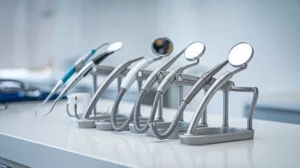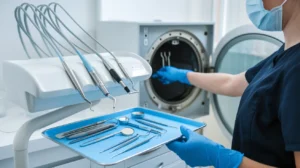
How to Choose the Best Dental Mouth Mirror for Oral Care
Picking the right dental mouth mirror might seem like a small task, but it’s actually pretty important for keeping your teeth and gums healthy. With so many options out there,

The right tool selection makes every tooth extraction successful. My years as a dental professional have taught me that smooth procedures depend on having the right forceps ready.
Dental forceps come in many types, and each design has its purpose. These tools are the foundations of successful extractions because they match specific tooth positions and root structures. Simply knowing their names and numbers isn’t enough.
Let me walk you through how to spot different extraction forceps and their special features. This detailed guide will show you the best forceps choices for your dental practice. You’ll learn proper maintenance tips and ways to get the best results during procedures.
Our dental practice depends on extraction forceps because they are the main tools we use to remove teeth from their sockets. These specialized tools give us a secure grip and minimize trauma to surrounding tissues.
Extraction forceps help us perform intra-alveolar extractions with elevators to remove teeth from the bone socket. The design has three key components:
These tools’ unique design lets us apply five major motions to lux ate teeth and expand the socket. The beaks adapt to the crown and root junction, not just the crown structure. This adaptation helps prevent root fractures during extraction.
Dental forceps’ quality varies significantly between manufacturers. Some companies use low-grade carbon alloy with minimal chromium content that rusts and wears down quickly. Surgical-grade stainless steel makes the best extraction forceps. French or German 420-grade stainless steel offers better durability than American-made alternatives.

Quality instruments made from premium surgical stainless steel can serve reliably for decades. Cheaper alternatives might last only a few years. The durability factor is vital to maintain consistent performance during procedures.
The anatomy of different teeth plays a vital role in choosing the right extraction forceps. Let’s look at the various types that dentists commonly use in practice.
Two distinct designs work best for upper teeth. The bayonet-pattern forceps excel at providing maxillary reach and have rounded beaks that match the lingual roots’ contours. These forceps come with pointed tips that grasp and remove teeth quickly.
Lower teeth need cow horn patterns and tri-pointed beaks. The cow horn design got its name from its unique shape and gives dentists better control during mandibular procedures. These tools provide a superior grip and are essential for lower molar extractions.
The right dental forceps can make the difference between a smooth extraction and a challenging procedure. Our experience shows that selecting proper tools is significant to build practitioner confidence and ensure patient comfort.
Several critical elements shape our forceps selection:
Choosing between serrated and non-serrated forceps is vital. Our experience shows that serrated forceps give you a more confident grip and reduce slippage during procedures. This better control guides you toward more efficient extractions and reduces stress for both practitioner and patient.
Our practice values professional expertise in forceps selection. Each type has a specific purpose, and dentists need to recognize the differences with expertise and finesse. Successful outcomes depend on having the right tools, whether you’re extracting a single tooth or multiple teeth.
Experienced colleagues are a great way to get knowledge about which forceps work best for specific procedures. Their practical experience helps you direct through the many options and make informed decisions for your practice.
Several manufacturers lead the dental instruments industry with their high-quality extraction forceps. HuFriedy Group, 115 years old and based in Chicago, has built its reputation by creating quality products and bringing breakthroughs to the field. Dental practitioners trust their products because of their steadfast dedication to performance enhancement.
YDM Corporation, a 75-year-old Tokyo-based company, operates with the motto “Best Partner of Dentists and Doctors”. Their extraction forceps deliver reliable results, especially when you have precise procedures.

Bader and Carl Martin represent the finest European craftsmanship. Their forceps offer these key features:
Carl Martin’s cow horn forceps stand out with exceptional grip strength that works well for molar extractions. House Brand and ProDent USA provide economical solutions that are available to practices without quality compromise.
These brands have proven their worth in thousands of dental offices nationwide. Their consistent performance confirms their stellar reputation. Henry Schein Dental supplies these manufacturers’ products, which helps us deliver the best patient outcomes.
The safety and longevity of dental forceps depends on proper maintenance. Our practice has developed detailed protocols to keep extraction instruments in the best condition.
The sterilization process starts right after each procedure. Blood stains become harder to remove if instruments aren’t cleaned within 15–20 minutes after surgery. Steam sterilization at temperatures between 134–137 degrees provides full sterilization. The pressure stays between 2.1 and 2.24 bar for 3 minutes.
Our sterilization protocol follows these steps:
Proper maintenance substantially extends the life of instruments. Lubrication of jointed and hinged instruments before sterilization is vital. The lubricant should be water-soluble without silicone and mineral oil. These substances can trap microorganisms and block proper sterilization.
Our forceps stay in dust-free environments. We keep them dry and away from non-sterile instruments. A lighted magnifying glass helps us spot problems early. These careful maintenance steps have substantially increased our extraction forceps’ service life. The instruments perform at their best during each procedure.
Quality dental forceps significantly affect extraction success rates. Our experience shows that investing in premium forceps from reputable manufacturers like HuFriedy and YDM Corporation delivers better procedure outcomes and extends tool life.
High-quality forceps become reliable partners in dental practice for decades with proper care. Your investment stays protected through regular maintenance, careful sterilization, and proper storage protocols that ensure patient safety. The right combination of tool selection and care guidelines creates smoother extractions with improved results.
Each forceps type has a specific purpose. Matching the right tool to unique extraction cases helps create efficient and comfortable procedures for dentists and patients alike. This knowledge about forceps types, materials, and maintenance gives you the foundation to make smart decisions for your dental practice.

Picking the right dental mouth mirror might seem like a small task, but it’s actually pretty important for keeping your teeth and gums healthy. With so many options out there,

Dental mirrors have come a long way. From simple reflective tools to sophisticated gadgets, they play a key role in modern dentistry. With constant innovation in dental mirrors, these aren’t

Hey there, dental pros! Today, we’re diving into something super important but often overlooked—how to properly mouth mirror sterilization. If you’re in the dental field, you know these little tools
At The Surgical Kit, we are committed to providing healthcare professionals with the finest tools to ensure precision and safety in every procedure.